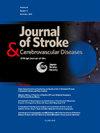急性缺血性卒中患者脑侧支血流状态与非取栓患者临床功能结局相关。
IF 1.8
4区 医学
Q3 NEUROSCIENCES
Journal of Stroke & Cerebrovascular Diseases
Pub Date : 2025-02-01
DOI:10.1016/j.jstrokecerebrovasdis.2024.108211
引用次数: 0
摘要
计算机断层扫描灌注(CTP)测量的低灌注指数比(HIR)已被证明可以预测急性缺血性卒中(AIS)的侧支血流状态。方法:在2018年至2020年期间,在初始卒中评估期间接受CTP的AIS患者的数据与Get with guide数据库相关联。结果:1442例患者获得CT灌注数据。排除后,保留391例患者(年龄69±14岁,男性54%,白人48%,黑人/其他52%),其中侧支血流良好295例(75%),侧支血流不良96例(25%)。侧支血流良好的患者更年轻(69±14比71±15,p=0.25), NIHSS中位值更低[7(25-75%组,3-13)比14(25-75%组,8-20)。结论:在非取栓候选的AIS患者中,HIR在CTP上测量的侧支血流良好状态与调整合共病后出院时良好的功能结局相关。本文章由计算机程序翻译,如有差异,请以英文原文为准。
Cerebral collateral flow state in acute ischemic stroke correlates with clinical functional outcomes in non-thrombectomy patients
Introduction
Hypoperfusion index ratio (HIR) measured by computerized tomography perfusion (CTP) has been shown to predict collateral flow state in acute ischemic stroke (AIS). Low HIR (<0.4) is indicative of good collateral flow state. This study tested the association between good collateral flow state and stroke severity and clinical outcome at discharge.
Methods
Data from AIS patients who underwent CTP during initial stroke evaluation were linked with Get With the Guideline database between 2018 and 2020. Patients with good collateral flow (HIR < 0.4) were compared to those with poor collateral flow (≥0.4). They were stratified based on modified Rankin Score (mRS) at discharge into good (mRS 0-2) or poor (mRS 3-6) outcomes. A collateral score of 0-3 was assigned using CTA's obtained at the time of AIS presentation. We used univariate and multivariable logistic regression analyses to test the association between good collateral flow state and good discharge outcome.
Results
CT perfusion data was obtained in 1442 patients. After exclusions, 391 patients (age 69 ± 14, 54% male, 48% white, 52% black/others) remained, of whom 295 (75%) demonstrated good collateral flow and 96 (25%) showed poor collateral flow. Those with good collateral flow were younger (69 ± 14 vs. 71 ± 15, p = 0.25) and lower median NIHSS [7 (25-75%ile 3-13) vs. 14 (25-75%ile 8-20), p < 0.001]. CTA collateral scores demonstrated a significant inverse correlation to HIR. Good collateral flow was associated with good outcome on discharge (OR 2.7, 95% CI 1.4-5.1). The association remained significant after adjustment for demographics and comorbidities (adjusted OR 3.2 (1.7-6.4).
Conclusions
In patients presenting with AIS who were non-thrombectomy candidates, good collateral flow state measured by HIR on CTP was associated with good functional outcome at discharge after adjustment for comorbidities.
求助全文
通过发布文献求助,成功后即可免费获取论文全文。
去求助
来源期刊

Journal of Stroke & Cerebrovascular Diseases
Medicine-Surgery
CiteScore
5.00
自引率
4.00%
发文量
583
审稿时长
62 days
期刊介绍:
The Journal of Stroke & Cerebrovascular Diseases publishes original papers on basic and clinical science related to the fields of stroke and cerebrovascular diseases. The Journal also features review articles, controversies, methods and technical notes, selected case reports and other original articles of special nature. Its editorial mission is to focus on prevention and repair of cerebrovascular disease. Clinical papers emphasize medical and surgical aspects of stroke, clinical trials and design, epidemiology, stroke care delivery systems and outcomes, imaging sciences and rehabilitation of stroke. The Journal will be of special interest to specialists involved in caring for patients with cerebrovascular disease, including neurologists, neurosurgeons and cardiologists.
 求助内容:
求助内容: 应助结果提醒方式:
应助结果提醒方式:


